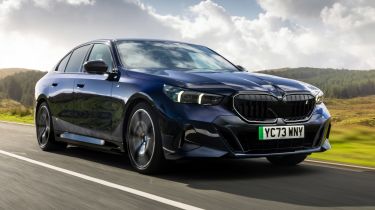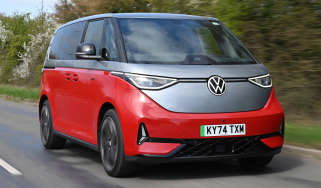BMW i5 eDrive40 M Sport 2023 review: the 5 Series gets electric power
The new all-electric BMW i5 boasts a long range and outstanding cruising comfort

Verdict
The BMW i5 is a car that brings the BMW 5 Series closer to its 7 Series sibling than ever before – not only in terms of comfort and refinement, but also on price. While business buyers can write off much of that initial outlay, its appeal is harder to justify for private drivers – despite the fact that costs have risen in line with inflation. This is an excellent car for business users, but private buyers might prefer a 520i.
The first all-electric BMW 5 Series is staring down the barrel of an eye-watering £74k base price. That’s quite a step when a quick online search reveals the E34-generation BMW 520i cost around £22,500 when it went on sale in 1988.
But factor inflation into that, and there’s only about £80 in it – with the older car actually coming out slightly more expensive like-for-like. Are cars one of the few luxuries that have resisted the uncontrollable spike in the cost of living?
Yes, and no. Spending this kind of cash on a three-box family saloon – albeit an electric one – will still be impossible to justify for most. It’s a pill no less tricky to swallow when you factor in three-year PCP costs of almost £1,000 per month, even with a 10 per cent deposit and 10,000 miles per year.
However you choose to finance your new i5, you’re getting a car that BMW says offers “the tech of a 7 Series, with the dynamics of a 3”. We’ll come back to the way this car drives in a moment, but from the second you sit inside it feels every bit worthy of its premium billing.
The materials used – despite the seats being covered in ‘Veganza’ leather alternative – are absolutely beautiful. Indeed, if you compared this latest i5 even with its immediate predecessor, you’d be amazed by the jump in quality. The widescreen infotainment system is running the latest operating system, and feels like an upgrade on the brand’s earliest OS 8 efforts – not least because it reintroduces the intuitive clickwheel on the centre console. The graphics are super-sharp, and there’s no end to the list of features buried within – many of which can be accessed via QuickSelect tabs.
The driving position is spot on, too. There’s loads of adjustment in the seat and steering wheel, and you can get nice and low, which is quite unusual for an electric car. The single left paddle behind the steering wheel looks a bit odd, but provides easy access to the car’s Boost function, which ups the ante for short bursts and provides peak power at the flex of your right foot.
For now, just two electric i5s are offered in addition to a 520i mild-hybrid petrol and a pair of plug-in hybrids. The eDrive40, as tested here, has 335bhp and 400Nm of torque, but at 2,205kg, this isn’t a light car. The 0-62mph dash takes a middling 6.0 seconds and while it feels suitably brisk off the line, acceleration tails off noticeably at the top end.
Coming back to handling, the i5 is certainly not as deft as a 3 Series (or i4) despite its maker’s claims. It feels suitably tied down and offers plenty of grip – in a typically BMW way – but the steering isn’t as sharp or reactive as existing 5 Series customers might expect. This contributes to a feeling that, overall, the car seems to favour comfort over outright driving fun.
Ride and refinement are excellent, however. It’s here, especially, where BMW’s associations with the larger 7 Series ring true, and when added to the generous space in the i5’s rear seats, you question why anyone would feel the need to upgrade. The 490-litre boot (520 litres on the petrol car) is a good size, and there’s a false floor revealing space for the charging cables.
Speaking of which, the i5 brings in BMW’s latest charging technology, including Plug&Charge, which allows owners to simply pull up to a compatible DC rapid charger without faffing with apps or payment cards. A lofty 205kW peak speed means a 10-80 per cent top-up should be possible in around 30 minutes – despite its large 81.2kWh battery.
Range is solid, and while we didn’t see class-leading efficiency on our fast test route, we suspect you’d get comfortably north of 300 miles driven on a mixture of urban, motorway and rural roads. A B-mode is accessed via a toggle of the gearlever, and ramps up the regenerative braking to a strong, but not aggressive, level. It’s easy to modulate, but won’t offer one-pedal driving as in the cheaper iX3. BMW claims up to 356 miles is possible from an entry-level i5, but spec differences can hack almost 20 per cent from that figure.
If all this sounds appealing, and you’ve got the means to run an i5 as a company car, a higher-rate tax payer will fork out just £592 per year in Benefit in Kind (BiK), rising to £889 in 2025/26. The M Sport Pro and M60i version cost a little more, but the difference is almost negligible.
All cars get the Veganza trim, adaptive LED lights and a Harman Kardon stereo, among other goodies. Base cars come on 19-inch wheels, while our test car rode on optional (£1,000) 20s. Real leather is £2,100, and a panoramic roof will set you back £1,600. Various packs bundle items together, but as pictured, our car retailed for a fraction over £92,000.
| Model: | BMW i5 eDrive40 M Sport |
| Price: | £74,105 |
| Powertrain: | 81.2kWh battery, 1x e-motor |
| Power/torque: | 335bhp/400Nm |
| Transmission: | Single-speed auto, rear-wheel drive |
| 0-62mph: | 6.0 seconds |
| Top speed: | 119mph |
| Range/charging: | 356 miles/205kW, 10-80% in 30 mins |
| On sale: | Now |












